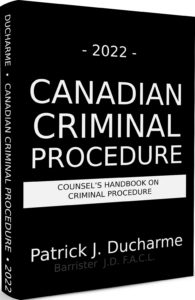 |
| Patrick Ducharme |
The Court of Appeal for Ontario in R. v. Bouchard1 found that the statutory definition of provocation in section 232 has no relevance when considering the impact of an alleged victim’s conduct on the accused’s state of mind in determining whether the elements of murder is proven by the prosecutor. Just two years earlier, the Court of Appeal for Ontario had concluded that evidence relevant to a provocation defence under section 232 may also be relevant to proof of the fault element for murder. The court suggested that a careful examination of the state of mind of the accused in relation to intention or lack of intention was a good reason for a “rolled-up instruction” to the jury by the trial Judge.
A rolled-up instruction refers to providing the jury with the various levels and descriptions of intention as they might relate to first-degree murder, second- degree murder and manslaughter. Rolled-up instructions effectively leave to the jury the task of deciding the state of mind of the accused at the time of the act that led to the unlawful death.
The ultimate question is, did the accused intend to kill? If, he intended to kill, the verdict is either first-degree or second-degree murder. This decision will depend upon the jury’s ability to find the requisite elements of planning and deliberation for first degree murder, or the intention to kill for second degree murder, and if not, the requisite intent for manslaughter.
The Supreme Court of Canada offers some assistance in R v. Tran.2 Mr. Tran was aware that his wife was involved romantically with another man. The couple was separated. One day he surprised his wife by arriving at her new residence unexpectedly, and of course, uninvited. He discovered all the evidence that he needed to support his apparently accurate belief of her infidelity toward him.
Although the appellant had come to the apartment with a sheathed knife in the pocket of his coat, he ran to the kitchen and came back into the bedroom armed with two butcher knives. He viciously attacked his wife and her lover.
Mr. Tran was tried before a Judge sitting without a jury for five offences arising out of these circumstances. His trial Judge had accepted the defence of provocation by holding that the Crown had failed to disprove the elements of provocation. The trial Judge therefore acquitted the appellant of second-degree murder and convicted him of manslaughter. The Alberta Court of Appeal disagreed. That court unanimously held that the defence of provocation had “no air of reality.”
The appeal to the Supreme Court of Canada only concerned his conviction for second degree murder on the other man (also with the same surname “Tran”). The Supreme Court of Canada agreed with the appellate court that there was no air of reality to the defence of provocation. Charron J. writing for the court focused on the fact that the deceased had been stabbed seventeen times, and six of the stabs were characterized as lethal wounds. She also pointed out the cunning deception of the accused in his effort to make it look like he was in imminent danger of death himself at the time he was stabbing the deceased.
The accused cut his own hand and arm with one of the knives and then placed that knife in the hand of the deceased while the deceased was lying motionless on the living room floor. This decision has significance for all future defences based on alleged provocation. The court found specifically that there was no “insult” within the meaning of section 232 of the Code. At trial the court had found that the insult was his estranged wife’s sexual involvement with another man.
However, the couple had separated. Her being with another man after they had separated could not form the basis of “a loss of control in the form of a homicidal rage, and, could not constitute “an excuse for any ordinary person of whatever personal circumstances or background, to amount to the “insult” upon one’s mind as in a state of mind where one is “unprepared for it or acting on the sudden at the time of the killing.” Section 232 of the Code provides as follows:
Murder Reduced to Manslaughter: Only If Facts Support
232 (1) Culpable homicide that otherwise would be murder may be reduced to manslaughter if the person who committed it did so in the heat of passion caused by sudden provocation. [Emphasis Added]
Tran had believed for a long time that his wife was no longer interested in him, and, also believed that she had an interest in another man. His suspicions were accurate. His discovery on the day that he found “another man” in her life and found her and the other man romantically engaged, should not, and did not in fact, in the court’s finding, meet the test of “in the heat of passion caused by sudden provocation.”

The above is the an excerpt of Patrick J Ducharme's book, Canadian Criminal Procedure, available at Amazon or in bulk through MedicaLegal Publishing along with Criminal Trial Strategies.
Subscribe to Patrick Ducharme's Youtube Channel
